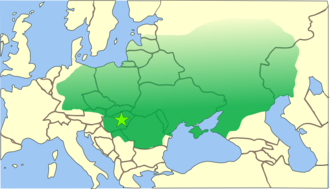453
Appearance
(Redirected from AD 453)
| Millennium: | 1st millennium |
|---|---|
| Centuries: | |
| Decades: | |
| Years: |
This article needs additional citations for verification. (June 2023) |
| 453 by topic |
|---|
| Leaders |
| Categories |
| Gregorian calendar | 453 CDLIII |
| Ab urbe condita | 1206 |
| Assyrian calendar | 5203 |
| Balinese saka calendar | 374–375 |
| Bengali calendar | −140 |
| Berber calendar | 1403 |
| Buddhist calendar | 997 |
| Burmese calendar | −185 |
| Byzantine calendar | 5961–5962 |
| Chinese calendar | 壬辰年 (Water Dragon) 3150 or 2943 — to — 癸巳年 (Water Snake) 3151 or 2944 |
| Coptic calendar | 169–170 |
| Discordian calendar | 1619 |
| Ethiopian calendar | 445–446 |
| Hebrew calendar | 4213–4214 |
| Hindu calendars | |
| - Vikram Samvat | 509–510 |
| - Shaka Samvat | 374–375 |
| - Kali Yuga | 3553–3554 |
| Holocene calendar | 10453 |
| Iranian calendar | 169 BP – 168 BP |
| Islamic calendar | 174 BH – 173 BH |
| Javanese calendar | 338–339 |
| Julian calendar | 453 CDLIII |
| Korean calendar | 2786 |
| Minguo calendar | 1459 before ROC 民前1459年 |
| Nanakshahi calendar | −1015 |
| Seleucid era | 764/765 AG |
| Thai solar calendar | 995–996 |
| Tibetan calendar | 阳水龙年 (male Water-Dragon) 579 or 198 or −574 — to — 阴水蛇年 (female Water-Snake) 580 or 199 or −573 |

Year 453 (CDLIII) was a common year starting on Thursday (link will display the full calendar) of the Julian calendar. At the time, it was known as the Year of the Consulship of Opilio and Vincomalus (or, less frequently, year 1206 Ab urbe condita). The denomination 453 for this year has been used since the early medieval period, when the Anno Domini calendar era became the prevalent method in Europe for naming years.
Events
[edit]By place
[edit]Byzantium
[edit]- July – Empress Pulcheria dies of natural causes at Constantinople.[1] She has commissioned many new churches in the city during her reign. Her death leaves Flavius Aspar (magister militum) as the dominant influence on her husband, Marcian.[2]
- Anthemius marries Marcia Euphemia, daughter of Marcian, and is elevated to the rank of comes.[3][4] He is sent to the Danubian frontier to rebuild the border defences.
Europe
[edit]- c. March – Attila the Hun is found dead in bed, after a wedding feast with the Goth princess Ildica. He dies of a nosebleed at his Hungarian stronghold, drowning in his own blood aged about 47.[5][6][7] The Huns celebrate a strava (lamentation) over his burial place with great feasting. Attila's son Ellac is appointed successor, but his brothers Dengizich and Ernakh divide the Hunnic Empire by establishing their own kingdoms north of the Black Sea (Ukraine), supported by vassal states.
- Theodoric II succeeds his brother Thorismund as king of the Visigoths, Thorismund having been murdered after he violated the alliance with the Western Roman Empire.[8]
Asia
[edit]- March 16 – Emperor Wen of Song is assassinated by his sons Liu Shao and Liu Jun, Prince Shixing, so that Liu Shao could become emperor.
- May 20 – Liu Shao is overthrown by another brother, Liu Jun who becomes Emperor Xiaowu of Song, and executed together with other members of his family on May 27.
- Ankō obtains the throne of his father Ingyō after the traditional order of succession and becomes the 20th emperor of Japan. His eldest brother Prince Kinashi no Karu commits suicide after being accused of an incestuous relationship with his sister Karu no Ōiratsume (according to the Nihon Shoki).
Births
[edit]- Brigit of Kildare, Irish patron saint (d. 524)
- Vedast, Frankish bishop (approximate date)
Deaths
[edit]- c. March – Attila, ruler of the Huns (b. 406)
- March 16 – Emperor Wen of Song, assassinated (b. 407)
- May 27 – executed:
- Liu Jun, Prince Shixing of the Liu Song dynasty (b. 429)
- Liu Shao, emperor of Liu Song (b. 426)
- Pan, concubine of Wen Di
- Empress Yin of Liu Song, forced suicide
- July – Pulcheria, Byzantine Empress
- Helian, empress of Northern Wei
- Thorismund, king of the Visigoths, assassinated
- Approximate traditional date:
- Emperor Ingyō of Japan
- Prince Kinashi no Karu of Japan
References
[edit]- ^ "Pulcheria (c. 398–453) | Encyclopedia.com". www.encyclopedia.com. Retrieved June 30, 2023.
- ^ "Pulcheria | Roman empress | Britannica". www.britannica.com. Retrieved June 30, 2023.
- ^ "R27470 Anthemius". www.forumancientcoins.com. Retrieved June 30, 2023.
- ^ Kent, John (1978). Roman coins. London: Thames and Hudson. p. 344. ISBN 0500232733.
- ^ "Attila | Biography, Battles, Death, & Facts | Britannica". www.britannica.com. May 19, 2023. Retrieved June 30, 2023.
- ^ Blazeski, Goran (December 23, 2017). "Attila the Hun is Believed to have Died of a Nosebleed on his Wedding Night | The Vintage News". thevintagenews. Retrieved June 30, 2023.
- ^ "8 Things You Might Not Know About Attila the Hun". History. June 1, 2023. Retrieved June 30, 2023.
- ^ Vaibhav. "Visigothic Kingdom of Europe - Kingdom of Toulouse". Retrieved June 30, 2023.